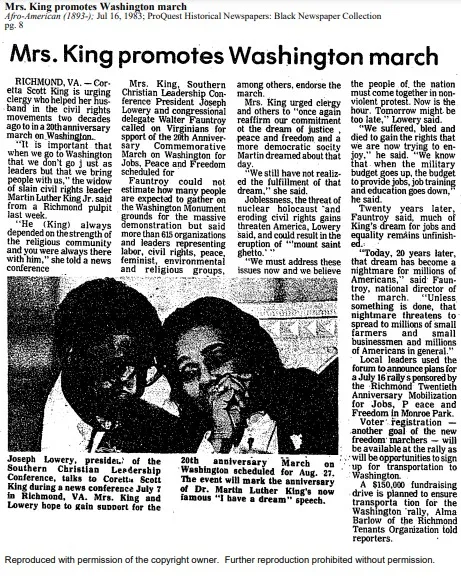Moving to the Foreground: A Look at Black Women and the March on Washington
Share
Explore Our Galleries
Breaking News!
Today's news and culture by Black and other reporters in the Black and mainstream media.
Ways to Support ABHM?
By Helen Bezuneh, The Afro
At this year’s March on Washington, Black women will stand at the forefront of the march, representing the efforts of many unrecognized women civil rights leaders over the decades.

When looking back at photos from the 1963 March on Washington, one can see the movement’s dark-suited male leaders standing hand in hand on the frontlines of the crowd, ambitiously leading a mass of about 250,000 people down the National Mall. Though a movingly evocative image to many, an untrained eye may be oblivious to a particular aspect of the photo: the march’s women leaders, who had equally involved roles in making the event happen, stand rows behind the male leaders, separated from the likes of Martin Luther King Jr.
Though women played key roles in the march and the larger Civil Rights Movement, the men preferred to bar women from the realm of public leadership. At this year’s March on Washington, however, women will stand at the forefront of the march, representing the efforts of many unrecognized women civil rights leaders over the decades.
“The good thing about this year’s march is that we are in a different time and the role of black women in politics in general has become a major force,” said Shavon Arline-Bradley, president of the National Council of Negro Women (NCNW), an organization that will co-chair the 2023 march. “Black women right now are the most consistent voting block and black women’s voices are now more consistent than ever before.”
The National Action Network is gearing up to host the 60th anniversary of the March on Washington on August 26, which they call a “continuation”, not a “commemoration” of the 1963 march. This year’s milestone event will place special emphasis on the pressing issue of hate crimes.
The original article has more details.
Learn about one of the activists at the original march or see how the march has grown through the years.
Find more stories about civil rights activism here.









Comments Are Welcome
Note: We moderate submissions in order to create a space for meaningful dialogue, a space where museum visitors – adults and youth –– can exchange informed, thoughtful, and relevant comments that add value to our exhibits.
Racial slurs, personal attacks, obscenity, profanity, and SHOUTING do not meet the above standard. Such comments are posted in the exhibit Hateful Speech. Commercial promotions, impersonations, and incoherent comments likewise fail to meet our goals, so will not be posted. Submissions longer than 120 words will be shortened.
See our full Comments Policy here.